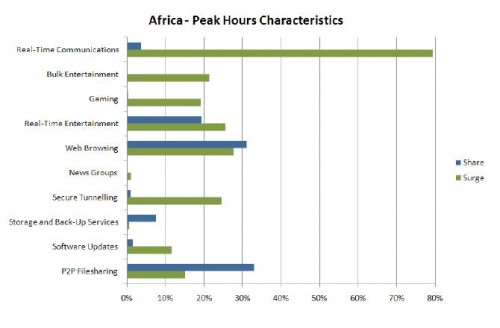Internet habits: more for now, less for later
In monitoring African Internet trends, it is important to also look at the global picture.
Astonishingly, in North America, estimates by a network management company (Sandvine) suggest that Netflix accounts for 20 percent of downstream Internet traffic (but not bandwidth) during peak home Internet usage hours. Recently, when the service launched in Canada, Netflix users occupied twice the bandwidth of YouTube users. Similar trends can be found in every corner of the globe, including Africa.
Sandvine’s 2009 report,”2009 Global Broadband Phenomena” found that Internet habits increasingly require large quantities of on-demand data:
Report findings include a dramatic shift in consumer behavior towards real-time “experience now” applications and away from bulk download “experience later” behavior. Compared to last year’s results, real-time entertainment traffic (streaming audio and video, peercasting, place-shifting, Flash video) has exploded to now account for 26.6 percent of total traffic in 2009, up from 12.6 percent in 2008.

Types of online information Africans access during peak hours. Click to enlarge. {Sandvine: 2009 Global Broadband Phenomena, 10}
Fortunately, the 2009 report provides insight into African habits. (The 2008 version grouped Europe-Middle East-Africa into one bucket, so no change-over-time comparison can be made from the trends). Some key findings:
- On a per-subscriber basis, North Americans consume the most YouTube videos followed closely by subscribers in Africa. (2)
- Peak time traffic in Africa is roughly 20 percent higher than the 24-hour average – this peak is the lowest of all global regions, suggesting that Africans use the Internet more consistently throughout the day. (10)
- In every region examined in this report, Web Browsing and Real-Time Entertainment are primary drivers of peak hours bandwidth consumption. Result: by showing a preference for interactive and sensitive applications, broadband subscribers are driving up the expected quality of service of the Internet. (12)












 Twitter
Twitter Facebook
Facebook Pinterest
Pinterest
[…] years ago, we commented on a 2009 Sandvine report that found on a per-subscriber basis, Africans consumed the second most […]